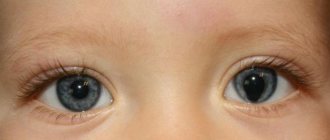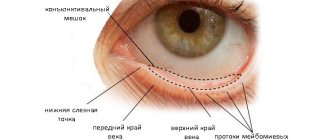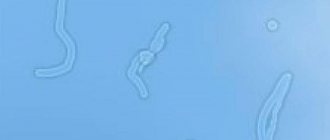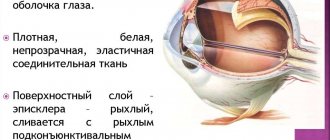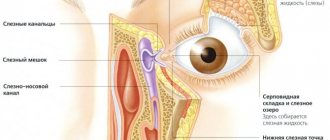The third eyelid is a membrane in the eyes of animals that performs the function of irrigating the organ of vision with tear fluid. It clears it of small impurities when blinking. In a healthy cat, the third eyelid should not be visible. If a whitish translucent film is noticed on your pet’s eyes, this may indicate a prolapsed membrane.
In such cases, the main thing is not to panic and in no case resort to self-medication. The nictitating membrane visible in a cat during wakefulness is not a disease, but one of the signs of pathology. Which one only a veterinarian can determine!
Photo of a healthy third eyelid of a cat
Provoking factors
Prolapse of the third eyelid in a cat can occur for various reasons:
- allergic conjunctivitis;
- prolapse;
- fungal, viral, bacterial infections;
- abnormal growth of cartilage;
- foreign body;
- eye injuries;
- adenoma of the nictitating membrane;
- diseases of internal organs;
- endo- and ectoparasites in the animal’s body;
- flu;
- predisposition at the genetic level - prolapse of the third eyelid is common in Persian and British cats.
Photo of a cat's prolapsed third eyelid
Allergic conjunctivitis
Allergies in a pet can occur for various reasons: intolerance to one or more components of a new cat food, household chemicals, etc. The symptoms of the reaction are complex - in addition to discharge from their eyes, the cat may experience itching, redness and peeling of the skin, hair loss, otitis media .
When third eyelid prolapse is one of the manifestations of allergies, it is first necessary to identify and exclude the allergen. To do this, you will have to keep a diary of the pet’s food and general condition for some time, where you need to write down all the foods and other substances that the cat shows a reaction after contact with.
Prolapse
In cases where the lacrimal glands of the third eyelid lose their correct anatomical position and they fall out of the conjunctival sac, we are talking about prolapse. As a result of the pathology, a pinkish round formation is observed in the inner corner of the cat's eye. The process can cause swelling, inflammation and even necrosis.
Important! Inexperienced owners often confuse lacrimal gland prolapse with third eyelid adenoma. However, an adenoma is a benign neoplasm, and prolapse is only a loss of the correct location of the glands.
Infectious lesions
Another possible cause of third eyelid prolapse is complications from infectious diseases, such as otitis media. The pathology occurs due to inflammation of the optic nerve. Sometimes the membrane can cover up to half of the eyeball. In such cases, a surgical operation is often performed - resection of the third eyelid.
Abnormal cartilage growth
As the kitten grows, sometimes the nictitating membrane breaks due to improper development of the cartilage. As a result, the third eyelid may become inflamed and fall out. It is impossible to correct the situation without antibiotic therapy and subsequent surgery.
Foreign body in the eye
At home, you can remove a foreign object from an animal’s eye by gently rinsing it with cotton swabs soaked in boiled water.
If washing does not bring results, you should show your pet to the veterinarian as soon as possible - he will remove the foreign body with special tweezers and prescribe therapy: eye drops and hydrocortisone ointment.
Mechanical eye damage
During games, hunting or as a result of a fight, a cat can get injured in the eyes. It is impossible to identify the damage on your own; it is better to show your pet to a doctor. The only possible first aid is to wash the eyes with a weak solution of furatsilin.
Adenoma of the third century
This benign neoplasm in the inner corner of the eye is often confused with inflammation or prolapse of the nictitating membrane.
The adenoma prevents the animal from closing its eyes normally, as a result of which microbes and dirt enter the mucous membrane, causing inflammatory processes.
Adenoma of the third eyelid is common in cats.
Internal pathologies
Diseases of the internal organs can also cause prolapse of the third eyelid. Adequate treatment and assistance in such cases are possible only after a correct diagnosis has been made. Without knowing which organ is damaged, there is no point in starting therapy - there will be no result.
Parasites
If, in addition to signs of prolapse of the nictitating membrane, the animal rubs its anus on the carpet, and symptoms such as lethargy and loss of appetite are observed, the pet most likely suffers from a parasitic infection.
A domestic cat can become infected with helminthiasis without even leaving the apartment: there is a possibility of larvae getting into the home along with a person’s shoes or clothing.
Flu
At the initial stage of influenza, your pet may experience eyelid prolapse. In addition, there may be an increase in temperature and suppuration in the eyeballs. You cannot delay treatment - the flu can lead to the death of your cat.
Allergic conjunctivitis
Attention! Attempts to straighten a cat's third eyelid on your own can lead to disastrous consequences, including removal of the eyeball!
Rudiments and atavisms: what is the difference?
Many people confuse rudiments with atavisms - other organs of our body. What is the difference?
Vestigial organs are extra parts of the body, but their presence is not a pathology, while atavisms are organs that were present in very distant ancestors, but were almost completely eliminated during the process of evolution. For example, the tail is an atavism. People have long been born without tails, but sometimes newborns have protrusions in the tailbone area, although this is a rare case.
The same can be said about people with clearly increased hairiness - this is a trait adopted from distant ancestors, not from immediate ones. Atavisms are extremely rare, while rudiments are present in the body of almost every person.
Prolapsed third eyelid in a cat: causes and treatment
Five signs that your cat may have a prolapsed or inflamed third eyelid:
- Tearing.
- Discharge of mucus or pus.
- Volumetric swelling in the corners of the eyes.
- Uncontrolled contraction of the eye muscles, causing spasmodic closing of the eyelids - blepharospasms.
- Inflammation prevents your cat's eyes from opening or closing.
The cat has an inflamed eye: how to treat it at home
The owner should take the animal to the veterinarian as soon as possible if at least one of the above symptoms is detected. The sooner the diagnosis is made and therapy is prescribed, the greater the cat’s chances for a complete cure.
The examination is carried out exclusively in the clinic, and usually includes:
- taking an anamnesis - interviewing the cat’s owner to find out the animal’s condition before going to the clinic (when the alarming symptoms appeared and how they developed);
- examination of the pet;
- general and biochemical blood test;
- taking a tissue sample from the conjunctiva for bacteriological examination or PCR, in order to clarify the nature of the causative agent of the disease;
- Ultrasound of the eyeballs and internal organs;
- CT, MRI or X-ray of the skull;
- control of intraocular pressure;
- fundus examination;
- examination of the cornea and pupils.
Important! After spaying or neutering, some cats have a visible film on their eyes. Therefore, after such an operation, it is worth observing your pet for several days before contacting a veterinary clinic.
The pet must be shown to a doctor
Adequate therapy
Treatment for a protruding third eyelid is prescribed by a veterinarian depending on the type of disease that led to this pathology:
- A cat with allergies is prescribed antihistamines. In advanced cases, hormonal medications may be required.
- If diseases of the internal organs are suspected, complex treatment can be prescribed only after a complete examination of the animal. Depending on the diagnosis, various methods and medications are used. In addition to taking medications, a special diet is prescribed, including medicinal food in the pet’s diet.
- When the cause of prolapse of the nictitating membrane is a viral, fungal or bacterial infection, antibiotics, antiviral and antifungal drugs of general or local action are prescribed in combination. Symptomatic therapy is recommended: antipyretic and painkillers, prevention of dehydration, taking vitamins. During this period, the cat is given rest and high-calorie nutrition.
- If the third eyelid falls out due to endo- or ectoparasites, first of all, anti-parasitic cleaning of the animal is prescribed. Next, symptomatic treatment is carried out, prescribed by a doctor depending on the situation.
Additional Information! If the cat has a weakened immune system, is recovering from another illness, the animal is losing weight or has a mild form of the flu, no treatment is prescribed.
In such cases, you just need to monitor the pet’s condition. If no improvement is observed within several days, it is necessary to introduce medicated food and a large amount of liquid into the pet’s diet.
Treatment of pregnant cats and kittens
When the nictitating membrane falls out in a pregnant cat or kitten, you should under no circumstances hesitate: not every medicine can be used to treat this category of pets.
The sooner a cat is diagnosed and prescribed therapy, the greater the chance of maintaining the pregnancy without negative consequences for the kittens, and sometimes for the life of the pet.
The health of kittens and pregnant cats should be monitored most carefully.
Construction of the century
The eyelids protect the front surface of the eye from adverse environmental influences and promote uniform hydration of the cornea and conjunctiva. In the eyelids, two layers are distinguished: superficial (anterior) - musculocutaneous, consisting of skin and subcutaneous muscle, and deep (posterior) - conjunctival-cartilaginous, consisting of cartilage and conjunctiva, covering the cartilage at the back. The boundary between these two layers is visible on the free edge of the eyelid as a grayish line located in front of the numerous openings of the meibomian glands (glands of the cartilage of the eyelids).
The anterior layer of the upper and lower eyelids contains eyelashes, near the roots of which there are sebaceous glands.
At the edge of the upper and lower eyelids, at the inner corner of the palpebral fissure, there are lacrimal puncta, which are the beginning of the lacrimal canaliculi.
In the thickness of both eyelids, closer to their free edge, there are plates of very dense connective tissue - eyelid cartilage. In humans, compared to monkeys, these cartilages are much more developed, accounting for about a third of the height of the eyelid.
The outer surface of the eyelids is covered with very thin skin.
Lower eyelid
Bounded below by the infraorbital groove. The shape of the lower eyelid varies little.
Upper eyelid
It reveals significant differences in its structure, which largely determine the characteristics of the eye area as a whole (see Epicanthus).
There are several types of folds of the upper eyelid: upper - supra-sulcata (orbital), located in the uppermost part of the eyelid, above the supraorbital groove; middle - sulcate, starting below the furrow; the lower one is the tarsal one, starting even lower.
At the junction of the skin of the upper eyelid and the skin of the roof of the orbit, a supraorbital groove is formed, which can be expressed to varying degrees.
Following doctor's orders at home
When a diagnosis is made and therapy is prescribed by a professional doctor, strict compliance with all the veterinarian’s instructions is very important. It is of no small importance to provide the sick animal with good conditions, rest and adequate nutrition. It is advisable to exclude physical activity.
Mastitis in cats: treatment at home
Several times a day, it is necessary to rinse the cat's eyes with the help of special preparations that relieve inflammation, stimulate self-cleaning and prevent the formation of tear stains.
After rinsing, special eye drops are usually used. Which ones exactly - the doctor decides. Drops are the most acceptable and convenient form of the drug, since gels and ointments are much more difficult to apply. Such medications should be placed under the animal’s lower eyelid with the index finger. To distribute the product evenly, massage the organ of vision.
Attention! Applying ointment or gel directly from the tube is prohibited! This may cause injury!
Gently washing a cat's eyes
Appendix
Like wisdom teeth, the appendix was necessary for humans due to the consumption of tough foods and fiber. It performed important functions in the digestion process. Over time, the need for a complex and large digestive tract disappeared, but the appendix remained.
But can it be considered a full-fledged rudiment? Some scientists have concluded that the appendix is a repository for beneficial bacteria, protected by the immune system tissue that is present in this organ. Thus, the appendix cannot be considered useless, and its vestigiality is currently debatable.
Prohibited methods of treatment
The cat's eyes are watery: what to do at home
Every cat owner should know which treatment methods should absolutely not be used:
- self-medication;
- treating an animal with medications intended for humans;
- attempts to independently return the fallen membrane to its place;
- removal of the third eyelid or lacrimal gland - even if the veterinarian insists on performing this operation, it is better to play it safe and consult in another clinic, since such an intervention can have serious consequences: kerato-conjunctivitis, ulcerative keratitis and even complete loss of vision.
How to make a double eyelid?
With the same desire as European women want to get rid of wrinkles on their faces, Asian women want to have a crease between the eyebrow and the upper eyelid. To do this, they resort to a variety of methods, ranging from cosmetic devices to surgical intervention.
The fold between the eyebrow and the upper eyelid makes the eyes appear more rounded.
Justified by this same eastern dream. We often see beautiful representatives of the Mongoloid race on the covers of magazines and TV screens, and we don’t even realize that nature did not give many of them double eyelids. But none of them will pose in front of a photo or video camera until a fold appears between her eyebrow and upper eyelid, allowing her eyes to become rounder and open wide.
Ordinary girls who are not show business or catwalk divas are not far behind them. Many of them are confident that, having a double eyelid, they will not only look more attractive, but also inspire more confidence among others. Moreover, some girls believe that it will come in handy even when looking for a job - employers are more favorable to its owners.
Measures to prevent prolapse of the nictitating membrane
Following simple rules for keeping a pet can significantly reduce the risk of pathology:
- systematic treatment against endo- and ectoparasites;
- keeping the cat's bedding and tray clean;
- timely vaccination;
- visual inspection of the animal once a week;
- preventive examination at a veterinary clinic twice a year;
- proper nutrition with quality feed.
Prevention and timely assistance are the key to your pet’s health and longevity.
The third eyelid in animals is a full-fledged structure of the eyeball, the protective function of which cannot be underestimated only because of its absence in humans. Therefore, when there is cause for concern, inflammation or prolapse of the nictitating membrane, you must definitely show your pet to a doctor.
The intervention of an ophthalmologist is not required in every case, but it is always better to play it safe to avoid disastrous consequences. It is important to understand that prolapse of the third eyelid in cats, especially during pregnancy, may indicate serious illnesses in the pet - from internal injuries to disorders of the nervous system.
Palmar muscle
Almost everyone has it. To check for the presence of the palmaris longus muscle in the body, you need to connect your thumb with your little finger and pull your hand up, straining your wrist. Previously, this muscle helped our ancestors cling to surfaces, climb trees, and strengthen their grip when jumping. Now it does not affect the grip strength of the palm in any way.
Depositphotos
